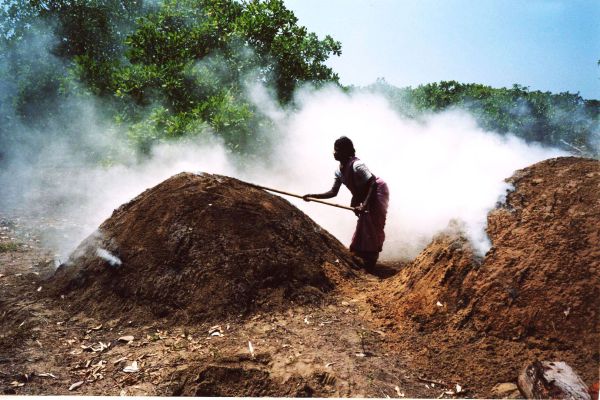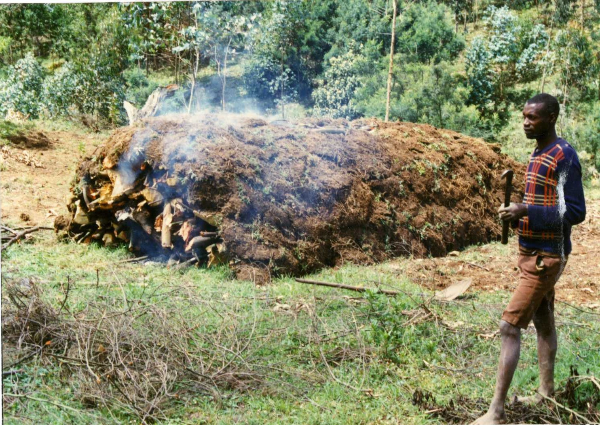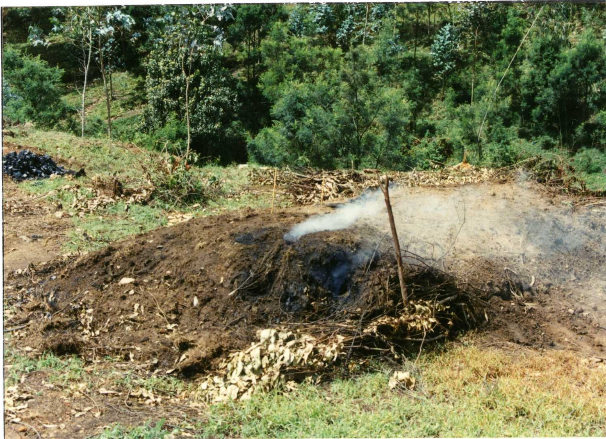
Traditional Earth Mound Kiln (direct carbonization) & charcoal consumption
Wood Charcoal Production with a traditional earth mound kiln near Pondicherry/ India.
A local family is doing this work for 35 years. The kilns are smoking for a period of about five days. It’s dangerous and unhealthy work for
the whole family and it engages a lot of pollution into the air.(photo: adam, 2004)
2nd and 3rd photo: an earth-mound kiln on the road to Ijenda/ Burundi/ Eastafrica. On the 2nd photo you see the amount of wood piled up for carbonization. After 5 days of smouldering and carbonization most of the wood is burned (9/10!), destroyed and some little charcoal recovered! (photo: adam, 1990)
Making Charcoal The Filipino Way (5 days) 2018
https://www.youtube.com/watch?v=bR9aqUbDBP0
Charcoal consumption per countries:
Kenya is consuming about 2 million tons of charcoal from wood per year for household purposes.
Zambia is consuming about 1 million tons per year.
In the case of these two countries alone, these 3 million tons of charcoal are produced mostly with this "earth-mound kiln technique" and this technology dates from the medieval age and is wasting the wood from our trees!
Only about 15kg (10kg to 20kg) of charcoal can be gained from 100kg of wood (oven-dry).
About 85kg of wood are destroyed and harmful smoke is polluting the environment (green house effect) during 5 days.
1 kg of insufficiently burned wood (smouldering) is polluting about 700m³ of the atmosphere.
About 17 million tons of wood are needed to produce these 3 million tons of charcoal, if the charcoal is produced with this ancient earth-mount-kiln technology.
About 11.900.000.000m³ air is polluted per year by this old method in these 2 countries alone!
We developed an innovative low-cost retort system (ICPS, Improved Charcoal Production System, or “adam-retort”) which is reducing the emission of harmful volatiles to up to about 70%.
Why is charcoal a widely accepted fuel in Southern Countries?
Take as an example the photo No8 from a charcoal stove in Malindi/Coast of Kenya. A lady wants to cook beans. She needs about 25€cents or 20 Kshillings to buy some charcoal to cook her beans. Once the charcoal is burning, she puts the pot with beans on the stove and she can leave the place and take care for other things. The charcoal stove does not need regular attention. After 1,5 hours the beans are readily cooked.
Much different however if she would use a wood fire. She regularly needs to
attend and feed the fire. If she does not carefully and constantly feed the fire with wood in a proper stove,
she may use and burn more wood- compared with the wood which is needed to produce the charcoal
used!
WE ARE NOT PROMOTING OR ADVERTISE THE USE OF CHARCOAL! IT's MORE APPROPRIATE TO BURN THE WOOD DIRECTLY (like e.g. done in many parts of India).
HOWEVER IF A CULTURE IS ALREADY USING HEAVILY CHARCOAL, THIS CHARCOAL SHOULD BE PRODUCED IN A MORE EFFICIENT AND ENVIRONMENTALLY FRIENDLY WAY!
Some words on charcoal stoves: (from http://www.charcoalproject.org/2014/09/an-efficient-charcoal-stove-for-kenya/ )
The stove’s performance is impressive. What’s equally impressive is the virtually wide open market that exists to improve efficiency and deliver cleaner, more sustainable fuels to 600 million Africans that fuel the $12 billion — yes, that billions with a B! — charcoal market on the continent.
I say wide open market because the focus of the clean cookstove movement has been more on developing improved wood-burning cookstoves, rather than charcoal-burning. There’s a good reason for that: traditional wood-burning cookstoves produce far more toxic emissions than charcoal-burning cookstoves. But the charcoal-burning cookstove market is significantly greater than the wood-burning cookstove market. What’s more, the impact of charcoal on the environment is significantly greater than that of woodfuel. Check out What’s Cooking in East Africa_w_additions. World Bank, a ppt that Burn Manufacturing shared and which which had somehow escaped our attention......
Here an example of pit carbonization for coconut shells.
A polluting way of making charcoal ! Look on minute 3.30 of the video
and
Coconut shell charcoal making (Look on minute 2.00 of the video)
and
STEPS ON HOW TO MAKE AN ULING (COCONUT CHARCOAL) (Look on minute 3.00 of the video)
and
Coconut Shell Carbonization (Look on minute 3.00 of the video)
and
Holzkohle Meiler (kiln) -warum kann man das (Rauch) nicht auf die Hand nehmen? - Bad Kohlgrub 2015 (my son Amir is asking "why can't i take the smoke in my hand :-) )
If you want to add a comment, go the the 3rd page "adam-retort kiln" to add a comment, thanks...




